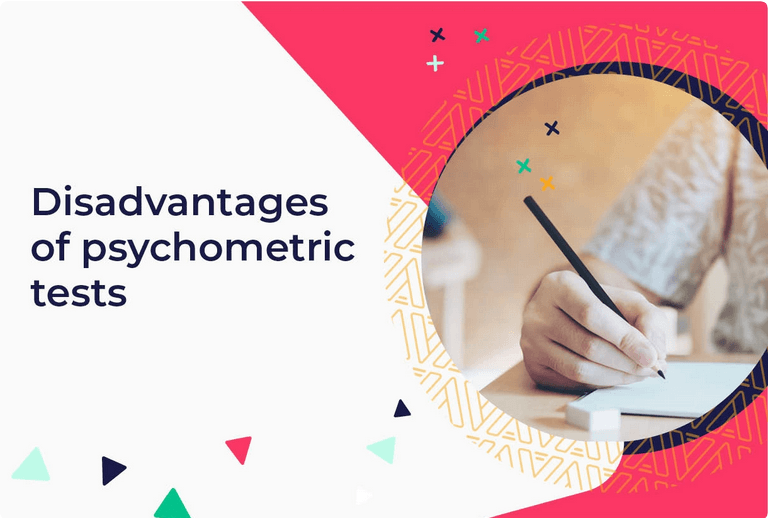Disadvantages of Psychometric Testing: What are the Limitations?
Wednesday 17th June

Table of Contents
Pros and cons of psychometric testing
Despite the benefits available to employers, psychometric testing isn’t without its faults. These disadvantages of psychometric testing can be broadly split into two separate sections: candidate performance and experience, and resources required.
Understanding the limitations of psychometric tests is key to making sure you take advantage of them in the right way - approaching skills-based recruitment from a game or task-based angle can help you improve time to hire, increase diversity and reduce costs when done correctly!
Want to read more about psychometrics?
There's a lot more information about psychometrics than we can share in this blog post! If you want to learn more, check out our full guide below.
Psychometric Testing Guide
Problem 1: Candidate performance and experience
A psychometric test’s design can influence how candidates respond to it. Ideally, you want a test that will allow candidates to express themselves authentically, giving you a clear picture of how they’ll behave in the role. Sadly, for three reasons, this isn’t always the case and they contribute to the limitations of psychometric tests…
Faking, and the management of faking
With traditional tests formatted as questionnaires, one of the disadvantages of psychometric testing can be candidates faking in high-stakes scenarios. When a job is potentially on the line, there’s no clear downside to faking in order to appear a more viable candidate for the role (except, of course, the toll this might take on one’s own conscience).
This is compounded by the growing amount of available information online about some of the most prevalent self-report tests. This can cover specific statements, as well as predictions on the constructs they’re measuring. With today’s candidates very comfortable online, and often conducting lengthy research before any assessment, they can in many cases prime their answers beforehand. This can lead to candidates either consciously ‘gaming’ many psychometric questionnaires, or subconsciously tailoring their responses to what they’ve read. Both of these can dilute the quality and impact of your data, which is particularly important when thinking about the disadvantages of psychometric testing in recruitment.
Traditional test developers have a common response to this, which creates its own problems: attempting to disguise what’s being assessed.
Take the following example (seen in the previous section):
| Undisguised statement | Disguised statement |
| “I am generally a creative person” | “I take a different route to work every day” |
This is a common example. As you can see, disguised statements are generally more specific, which can complicate more than it clarifies. There are various reasons you might regularly shake up your route to work, many completely separate from any creative streak you might have. As such, the process of disguising these statements can actually dilute their effectiveness and create space for misunderstood data.
So, traditional questionnaire formats can invite both conscious and unconscious faking. These psychometric test disadvantages can also create confusion in their efforts to combat said faking. This could actually impact the quality of your data and your ability to predict the best hire for your organisation.
Did you know?
While faking can be a conscious process, however, in many cases this actually occurs subconsciously. Not all those who fake are attempting to deceive you. It’s simply an unconscious bias that prompts candidates to respond in a more socially-desirable way.
Self-awareness and experience
When thinking about the limitations of psychometric tests, it’s also worth considering that self-report formats rely on candidates to actually know themselves well. For those just entering the workplace, though, they’re likely to have little working experience (in fact, those joining the workforce now are the least likely of any age group to have been previously employed in a part-time capacity). As such, they’re unlikely to have a clear picture of how they’d actually respond to certain scenarios. This can lead down two paths:
- Honest guesswork (i.e., how candidates would like to think they’d react)
- Faking (i.e., what candidates believe the employer wants to hear).
Both of these can impact the relevance and value of any data arising from the psychometric assessment in question.
Anxiety
Even if a candidate is doing their best to answer authentically, the typical question/answer format can induce levels of anxiety that prevent them from giving a true account of themselves. This is because each question sprouts a whole network of associated thoughts. Which qualities is the question probing for? How does each answer reflect on me as a candidate? How will my answer contribute to my chances of getting this role? Anybody who’s completed this type of test will probably remember them as generally quite intense, or, at worst, stressful.
That’s because all of this mental chatter prevents what is called cognitive flow – the ability to immerse oneself in a task and respond intuitively and authentically. This in turn results in a huge disadvantage of psychometric tests, in that the effectiveness of self-report formats suffer in a high-stakes environment precisely because there’s so much riding on each question for candidates. In this context, the concept of flow really doesn’t exist.
This can also have a knock-on effect when it comes to your employer brand. Anybody in talent acquisition knows how important this is, but, if processes are unduly stressful, this is unlikely to recommend you to the candidate. IBM has found that 60% of applicants talk to friends and family about their experience, meaning the impact of a stressful psychometrics can be wide-reaching. This is likely to be amplified if you incorporate psychometric tests into a wider assessment day, which are intense enough as it is!
Free Playbook: CV-less Hiring
Learn to navigate the skills crisis by looking beyond the CV. Get access to our free in-depth guide on rethinking employment practices, scrapping the CV, and how to implement hiring for potential in your company.
Download the playbook
Problem 2: Resources required
Frustratingly, psychometrics aren’t a plug-in-and-go option. There are barriers to entry for many, which mean their benefits aren’t always accessible without considerable investment. Let’s look at two of these barriers:
Knowledge & training
Most products in the field require training, potentially from the British Psychological Society (BPS). While 30% of companies using psychometrics do so without encouraging any training, it can be a prerequisite for some test providers. Poor use of psychometrics won’t just fail to benefit you – it may actually damage the effectiveness of your hiring strategy (and cost you plenty in unsuitable hires).
So this particular disadvantage of psychometric testing in recruitment can pose a dilemma: either risk undercutting your process on the one hand, or spend considerable time and money on training. Though courses can last for just a few days (along with some additional coursework), even this timespan can be hard to spare. You’ll also need to pay for the training, of course.
Cost
We’ll prefix this section by saying that the initial investment, if made wisely, will likely save you money. When you take the cost of bad hires into account (which, as discussed here, can be considerable), spending on valid, reliable psychometric tests should be considered in terms of its value. But, that said, psychometric validity and psychometric reliability don’t always come cheap. At a time when HR budgets are likely being constrained, it’s important to consider whether the initial outlay is feasible for the outcomes expected. This also makes it vital to identify assessments that are truly valid and reliable.
Are you an employer?
Find out how Arctic Shores can help you. Get in touch today to streamline your hiring - improving cost efficiency, reducing time to hire and eliminating bias.
Book a demo
Disadvantages of psychometric testing - FAQs
We've tried to give you a detailed overview of the limitations of psychometric testing, but it's been a lot, so we understand if some of it hasn't stuck! If you'd prefer a more concise overview, check out our answers to some of the most frequently asked questions on the topic below.
> What are the problems with psychometric testing?
Psychometric testing faces challenges such as candidates consciously or subconsciously providing socially desirable responses, especially in traditional self-report questionnaires. This can lead to inaccurate data, affecting the quality of hiring decisions.
> What are the advantages and disadvantages of using psychometric tests?
Psychometric tests offer advantages like standardised measurement of cognitive abilities and personality traits, aiding objective hiring decisions. However, disadvantages include potential candidate anxiety affecting performance and the need for specialised training to administer and interpret results, which can be resource-intensive.
> What are the criticisms of psychometric testing?
Critics argue that psychometric validity and psychometric reliability can be very difficult to ensure. As well as this, the rise of AI tools like ChatGPT enables candidates to game traditional assessments, further undermining their effectiveness. This is why we use a task-based approach which helps to circumvent these problems.
Want to learn more about our assessment?
We're proud to offer a task-based assessment grounded in science, and companies around the world have already got on board to eliminate bias in their recruitment process, reduce time to hire and turnover rates, and save money across the entire hiring department.
Start your Skills-based hiring journey today
Get in touch to understand how our task-based assessment has helped 150+ leading employers future-proof their hiring process.
Contact us
Read Next
Sign up for our newsletter to be notified as soon as our next research piece drops.
Join over 2,000 disruptive TA leaders and get insights into the latest trends turning TA on its head in your inbox, every week
Sign up for our newsletter to be notified as soon as our next research piece drops.
Join over 2,000 disruptive TA leaders and get insights into the latest trends turning TA on its head in your inbox, every week


